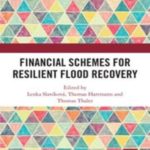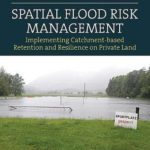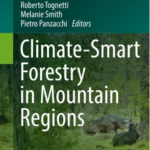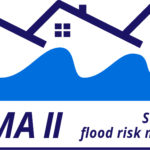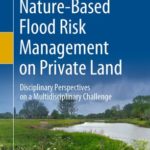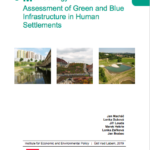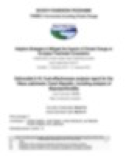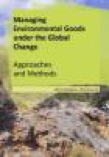
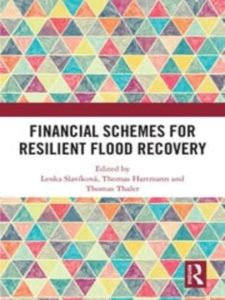
Financial Schemes for Resilient Flood Recovery
How to design financial instruments in a flood recovery period and in the long run?
Financial schemes for flood recovery, if properly designed and implemented, might increase flood resilience. However, options for the increase of flood resilience during the recovery phase are to a large extent overlooked and the diversity of existing schemes shows that there has been a lack of consensus on how to achieve resilient flood recovery.
Financial Schemes for Resilient Flood Recovery investigates how the implementation of financial schemes (government relief subsidies, insurance schemes, buy-outs, etc.) might increase flood resilience. The chapters included in this edited volume address the following questions: Shall government relief subsidies exist when there is flood insurance in place, and, if so, how might they both be coordinated? Where (or how) to decide about build back better incentives and where to go for planned relocation programs? What is the distributional equity of financial schemes for flood recovery, and has it been sufficiently treated?
The book covers different approaches to flood recovery schemes with specific intervention rationales in different countries. Empirical evidence provided clearly shows the great diversity of financial flood recovery schemes. This diversity of state-funded schemes, private-based insurance schemes, and hybrids as well as planned relocation schemes indicates a lack of a consistent and strategic approach in flood risk management and flood resilience about flood recovery.
The chapters in this book were originally published in the Environmental Hazards.
Full citation: Slavíková L,, Hartmann, T., & Thaler, T. (2021). Financial Schemes for Resilient Flood Recovery (1st ed.). Routledge, Taylor & Francis Group.
Spatial Flood Risk Management: Implementing Catchment-based Retention and Resilience on Private Land
The book calls for the interconnection of land policy instruments and flood risk management in Europe.
Centralising the role of land and landowners, Spatial Flood Risk Management brings together knowledge from socio-economy, public policy, hydrology, geomorphology, and engineering to establish an interdisciplinary knowledge base on spatial approaches to managing flood risks. The final LAND4FLOOD COST Action book brings together more than 25 authors from different disciplines and different European countries to discuss existing challenges.
Open Access book is available here: Hartmann, T., Slavíková, L., Wilkinson, M. (2022): Spatial flood risk management. Edward Elgar.
Review of Policy Instruments for Climate-Smart Mountain Forestry
What instruments can be used to implement climate-smart forestry in mountain areas of Europe?
Abstrakt: Implementing the Climate-Smart Forestry (CSF) concept into practice requires interaction among key stakeholders, especially forest owners and managers, policymakers (or regulators in general), forest consultants, and forest users. But what could be the most effective policy instruments to achieve climate smartness in mountain forests? Which ones would be the most acceptable for forest owners? And for the local forest communities? Should they be designed and implemented with the use of participatory approaches or rather on a top-down basis? This chapter summarizes key policy instruments structured in three subsequent categories: command-and-control, voluntary market-based instruments, and community cooperation. It provides examples of their functioning in the forestry sector and discusses their suitability for the implementation of climate smart forestry. It appears that there are many policy instruments used with varying degrees of success such as forest concessions or voluntary certification schemes. A wide range of instruments are responding to direct regulation; this has been seen as insufficient to deal with natural hazards and calamities.
Citation: Dubova L. et al. (2022) Review of Policy Instruments for Climate-Smart Mountain Forestry. In: Tognetti R., Smith M., Panzacchi P. (eds) Climate-Smart Forestry in Mountain Regions. Managing Forest Ecosystems, vol 40. Springer, Cham. https://doi.org/10.1007/978-3-030-80767-2_14
Download: ↓ Review of Policy Instruments for Climate-Smart Mountain Forestry
STRIMAII: Saxon-Czech Flood Risk Management II
Vulnerability to floods, nature-based measures and importance of small water bodies
A series of three studies and leaflets dedicated to different aspects of floods, solved by the project Saxon-Czech Flood Risk Management II, funded by the European Union via the European Regional Development Fund. For more information about STRIMA II, click zde.
Vulnerability
Globally, floods are among the most serious natural dangers, which is why we need to focus on reducing their impacts. However, that requires both detailed understanding of their different aspects and grasping their complex nature. Vulnerability belongs among the key terms in flood risk management. The degree of vulnerability is determined separately for the population and for different types of structures or activities, for example. Vulnerability is described in detail in the leaflet and the study.
Bibliographic reference: Raška, P. et al. (2018). Vulnerability to floods: Information material on flood vulnerability assessment for public administration and private entities (Zranitelnost povodněmi: Informační materiál k hodnocení zranitelnosti povodněmi pro veřejnou správu a soukromé subjekty). J. E. Purkyně University in Usti nad Labem
For download:
Information leaflet: What is flood vulnerability? Summary for public administratrion and private entities (English version)
Information leaflet: Wie ist Verletzbarkeit durch Hochwasser zu verstehen? (German version)
Nature-based flood protection measures
Nature-based flood protection measures are implemented in landscape, on watercourses or in human settlements and make use of green and blue infrastructure. In addition to these functions, they often provide many more benefits for ecosystems (such as soil protection from erosion). Measures implemented to protect from floods include polders, pools and baulks. Their function with regard to floods consists in capturing water in landscape, slowing down its progress and capturing torrential rains and resulting flood waves. The outcomes focus primarily on economic aspects (costs and benefits) and on ecosystem services provided.
Bibliographic reference: Macháč, J. et al. (2018). Classification and evaluation of nature-based flood protection measures in selected environmental public goods (Klasifikace a hodnocení přírodě blízkých protipovodňových opatření na vybraných veřejných statcích životního prostředí). J. E. Purkyně University in Usti nad Labem
For download:
Information leaflet: Nature-based flood protection solutions and their benefits (English version)
Information leaflet: Was versteht man unter naturnahen Hochwasserschutzmaßnahmen? (German version)
Small water bodies in landscape: their functions and barriers to their construction
Drought periods as well as torrential rains require a change in water source management. One possible strategy is to improve the ability to retain precipitation as close as possible to its place of impact, thus slowing water runoff from the catchment area. Solutions include establishment of small water bodies in landscape, specifically various types of pools, systems of pools and wetland ecosystems. The advantage is that some of them do not need to be permanently filled with water and they have no technical outflow controls, and they simultaneously perform a number of interconnected functions in the landscape. However, their implementation is associated with possible barriers, such as ownership relations in the area and insufficient funding sources. See the study and the leaflet for more information.
Bibliographic reference: Slavíková, L. et al. (2019). Small water bodies in landscape as a comprehensive tool for water retention in catchment areas: Institutional analysis results (Drobné vodní plochy v krajině jako komplexní nástroj k retenci vody v ploše povodí. Výsledky institucionální analýzy). J. E. Purkyně University in Usti nad Labem
For download:
Information leaflet: Small water bodies in landscape: their functions and barriers to their construction (English version)
Information leaflet: Kleinwasserflächen in der Landschaft: ihre Funktion und Hindernisse bei der Errichtung (German version)
Nature-Based Flood Risk Management on Private Land
What are the challenges of natural flood retention measure implementation on private land?
Abstract: Nature-based solutions (NBS) in Flood Risk Management require more—and mostly privately owned—land, and more diverse stakeholder involvement than traditional (grey) engineering approaches. This also implies that there are challenges related to different disciplines. Flood risk management with NBS is an issue not only of technical expertise, but it asks for land-use planning, economics, property rights, sociology, landscape planning, ecology, hydrology, agriculture and other disciplines to cope with the challenges of implementing them. Nature-based FRM is thus an inter- and transdisciplinary endeavor. In the book, cases are presented that develop, demonstrate or deploy innovative systemic and yet locally attuned NBS (i.e., green and blue infrastructure and ecosystem-based management approaches, in rural and urban areas).
Hartmann T., Slavíková L., McCarthy S. (eds) Nature-Based Flood Risk Management on Private Land. Springer, Cham. ISBN: 978-3-030-23841-4
Download: Nature-Based Flood Risk Management on Private Land
Methodology for Economic Assessment of Green and Blue Infrastructure in Human Settlements
A method of monetary valuation and comparison of costs and benefits of green and blue infrastructure.
Green and blue infrastructure provides a variety of benefits in the form of ecosystem services for residents, workers and city visitors. At the same time green and blue infrastructure effectively deals with and prevents more and more frequent phenomena related to climate change such as intensive rainfall, drought or heat waves. Economic assessment is a tool that contributes to spreading knowledge about the benefits of green and blue infrastructure and at the same time represents an economic argument confirming its usefulness, which supports decisions about its implementation. For this purpose, the methodology for economic assessment of green and blue infrastructure in human settlements was developed by the IEEP team. The certified methodology includes a transparent procedure based on an analysis of costs and benefits of individual measures including examples of economic assessment in practice.
The certified methodology can be used at the government level or by local administrations as well as by interest groups and residents. Outputs of the methodology and valuations of green and blue infrastructure elements can be useful when planning new public areas (e.g., squares, parks, playgrounds, streets, etc.) or when deciding about utilization of areas and construction of specific elements (e.g., green roofs and walls, communal gardens, etc.).
Reference: Macháč, J., Dubová, L., Louda, J., Hekrle, M., Zaňková, L. et Brabec, J. (2019). Methodology for Economic Assessment of Green and Blue Infrastructure in Human Settlements. Ústí nad Labem: Institute for Economic and Environmental Policy (IEEP).
Download: ↓ Methodology for Economic Assessment of Green and Blue Infrastructure in Human Settlements (pdf.)
Cost-effectiveness analysis of the water quality improvement in the Orlik reservoir
Report of the REFRESH project on the economic analysis of the eutrophication problem solution in large Czech reservoir Orlik.
Continue reading
From Government to Governance? New Governance for Water and Biodiversity in an Enlarged Europe
Book dealing with the environmental governance changes in post-socialist countries of Central and Eastern Europe.
Continue reading
Managing Environmental Goods under the Global Change – Approaches and Methods
Book focused on ecosystem service provision under various management schemes.
Continue reading


